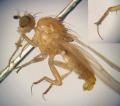Diptera.info :: Identification queries :: Diptera (eggs, larvae, pupae)
|
Sciomyzidae ? > Elgiva
|
|
| solito de solis |
Posted on 16-05-2015 22:57
|
|
Member Location: Liege, Belgium Posts: 404 Joined: 05.08.13 |
Good evening I would be interested with your opinions regarding this larva living in a strange pond whose I suspect the water very polluted (today by soap or detergent) I propose a picture of this larva I found floating close to a plant piece. This larva has alike a pair of short prolegs close to the head (mouth) aperture The length of the contracted body is about 6 mm  the head  anal spiracles  Could it be a Scatophagidae ? thanks for the help Solito de Solis Edited by solito de solis on 24-11-2015 19:07 |
|
|
|
| atylotus |
Posted on 17-05-2015 09:01
|
|
Member Location: Amsterdam, NL Posts: 1166 Joined: 29.05.09 |
Sciomyzidae, probably Elgiva spec. Do you have a view of the terminal segment taken from behind (caudal view)? |
|
|
|
| solito de solis |
Posted on 17-05-2015 10:07
|
|
Member Location: Liege, Belgium Posts: 404 Joined: 05.08.13 |
Thank you for this remark Indeed, I had the feeling of possible Sciomyzidae I think I have not the view you asked terminal segment taken from behind) Sorry... I will propose you the clip, in the afternoon And in the clip... you will see the movment of the anal part, a little blurry, but we can guess (you will guess better than me) merci SDS Edited by solito de solis on 17-05-2015 11:00 |
|
|
|
| solito de solis |
Posted on 17-05-2015 12:40
|
|
Member Location: Liege, Belgium Posts: 404 Joined: 05.08.13 |
three pictures more  mouth view  |
|
|
|
| solito de solis |
Posted on 17-05-2015 14:27
|
|
Member Location: Liege, Belgium Posts: 404 Joined: 05.08.13 |
As I told you, here is the mini video clip concerning this larva (unfortunately sometimes a little bit blurry when the animal is moving) If I consult Manual of neartic diptera Vol2 pp936 , I have seen Elgiva solicita Are we close to this attribution ? Merci beaucoup for the help YouTube Video |
|
|
|
| atylotus |
Posted on 17-05-2015 17:50
|
|
Member Location: Amsterdam, NL Posts: 1166 Joined: 29.05.09 |
Elgiva sp. for sure. It has a relatively long last segment which could also be seen in your first photo and in 0:21 sec. in your video I see 2 small fused ventral anal lobes, so it definitely Elgiva. To be sure about the species name (cucularia=rare, solicita=common) you need to study the number of lobes in the anterior spiracle. However solicita is very common as larva and I have seen cucularia only once (as a pupa: http://www.dipter...to_id=6591)
Edited by atylotus on 17-05-2015 17:54 |
|
|
|
| solito de solis |
Posted on 18-05-2015 06:03
|
|
Member Location: Liege, Belgium Posts: 404 Joined: 05.08.13 |
Merci pour cette réponse Thanks for this answer and for the attention you paid to this organism (they are so cute) You mention the anteriror spiracle Is it this feature close to the mouth ?(2)  solito |
|
|
|
| atylotus |
Posted on 18-05-2015 06:46
|
|
Member Location: Amsterdam, NL Posts: 1166 Joined: 29.05.09 |
no, it isn't, this looks more like some kind of maxillary palp. The anterior spiracle is positioned on both sides of the head. It is placed at the front of those (silvery colored) breathing tubes inside the body. Between the first and second thoracic segment they come into contact with the body surface. Probably they have about 5-7 lobes. |
|
|
|
| solito de solis |
Posted on 18-05-2015 11:01
|
|
Member Location: Liege, Belgium Posts: 404 Joined: 05.08.13 |
If these spiracles are located here,  then I missed the opportunity to film or photograph these features This larva is not too young to offer all the characteristics necessary for a complete determination? Nevertheless, I thank you at all SDS Edited by solito de solis on 18-05-2015 11:02 |
|
|
|
| atylotus |
Posted on 21-05-2015 06:19
|
|
Member Location: Amsterdam, NL Posts: 1166 Joined: 29.05.09 |
yes, this would be the most logical position of the anterior spiracle. |
|
|
|
| Jump to Forum: |












